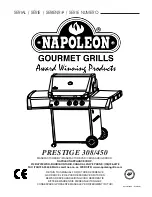
4
IMPORTANT DO'S AND DON'TS
DO'S
Read the entire instruction manual before operating the
gas grill.
Maintain proper clearance to combustibles (410mm to rear
of unit, 180mm to sides). Additional clearance is recom-
mended near vinyl siding or large panes of glass.
Leak test the unit before initial use, annually and whenever
any gas components are replaced.
Follow lighting instructions carefully when operating grill.
Burner controls must be off when turning supply cylinder
valve on.
Ensure sear plates are positioned properly according to
sear plate installation instructions. The holes must be
towards the front of the gas grill.
Clean grease tray and sear plates regularly to avoid build-
up which may lead to grease fires.
Remove warming rack before lighting rear burner. (The
extreme heat will damage the warming rack.)
Do not route hose underneath drip pan - proper hose
clearance to bottom of unit must be maintained.
Do not use condiment tray to store lighters, matches or
any other combustibles.
Do not locate unit under unprotected combustible con-
struction.
Do not operate rear burner with main burners operating.
Do not leave grill unattended when operating.
Do not light burners with lid closed.
Do not move grill when hot or operating.
Do not use water to control flare-ups.
Do not use a pressure washer to clean any part of the unit.
DON'TS
• If the hose and regulator are not included by the manufacturer, then only hoses and regulators which meet national and
regional codes are to be used.
• Do not connect the appliance to a permanent gas installation.
• Ensure that the hose does not come into contact with grease, other hot drippings, or any hot surfaces on the appliance.
• Check hose regularily. In the case of rips, melting or wear, replace hose before using the appliance.
• The recommended hose length is 0.5m. The hose must not be longer than 1.5m.
• Ensure that the hose is twist and kink free when installed.
• Replace the hose before expiry date printed on the hose.
GAS HOSE
GAS CYLINDER
Use only gas cylinders which meet national and regional codes. The minimum cylinder size for butane units is 13kg, and for
propane units is 6kg. Ensure that the cylinder can provide enough fuel to operate the appliance. If in doubt, check with your
local gas supplier.
• Use caution when handling the cylinder valve.
• Never connect a cylinder which does not meet local codes.
•
All cylinders 7kg or larger must be placed outside the enclosure (under the right side shelf) on level ground. Cylinders
smaller than 7kg may be placed inside the enclosure, in the hole in the bottom shelf. Only cylinders connected to the appliance
may be stored in the enclosure, or close to the appliance. Spare cylinders must not be stored in close proximity of an operating
unit. Cylinders must not be exposed to extreme heat or direct sunlight.
IMPORTANT: Ensure that the hose is routed to maintain proper clearance to the underside of the unit. Hoses that contact
high temperature surfaces may melt and leak, causing a fire.
CYLINDER CONNECTION:
Ensure that the gas regulator hose is kink free. Remove the cap or plug from the cylinder
fuel valve. Tighten regulator to cylinder valve.
Leak test all joints prior to using the barbecue. A leak test must be performed
annually, and each time a cylinder is hooked up, or if a part of the gas system is replaced.





































